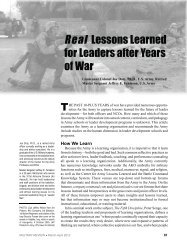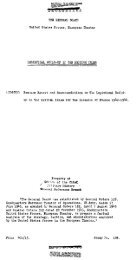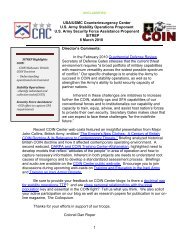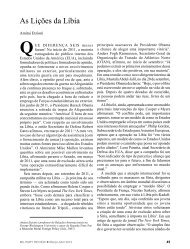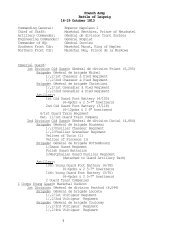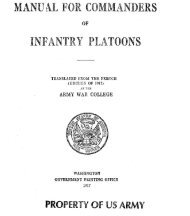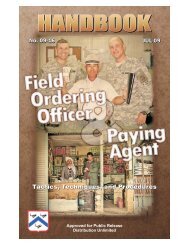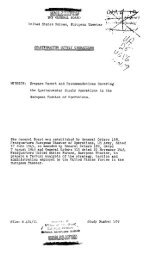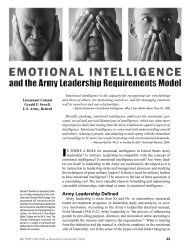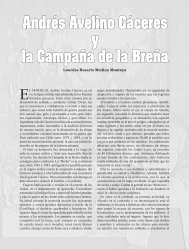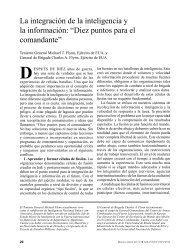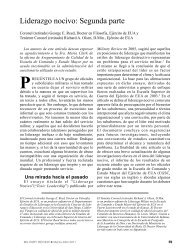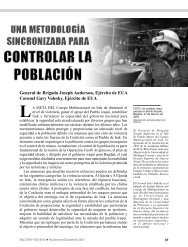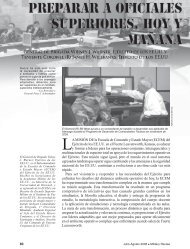Armor Magazine Counterinsurgency Selected Works - US Army
Armor Magazine Counterinsurgency Selected Works - US Army
Armor Magazine Counterinsurgency Selected Works - US Army
You also want an ePaper? Increase the reach of your titles
YUMPU automatically turns print PDFs into web optimized ePapers that Google loves.
ers; and the Kufa Mosque, which is second only in religious significance<br />
to the Ali Shrine and is the stronghold of the militia<br />
with more than 600 fighters.<br />
To the north of the Ali Shrine, lies the largest Shia burial ground<br />
in the world. This area was infested with insurgents from the Ali<br />
Shrine and Kufa, and was used as a weapons cache, and as the<br />
task force would later learn, a sensitive site requiring precision<br />
fires.<br />
This article shares lessons learned and methods developed during<br />
the fight in Najaf/Kufa. Although, the fight will never be labeled<br />
a modern 72 Easting, or spearhead into Iraq by the 3d Infantry<br />
Division, the intensity, tempo, and constraints have application<br />
for future employment of armor forces in urban terrain.<br />
Tempo and Campaigning<br />
Understand the complexity of the battlefield. In the case of<br />
Najaf and Kufa, considering political backlash from damaging<br />
holy sites and creating unnecessary collateral damage was paramount<br />
in all planning and execution. Soldiers were well aware<br />
of the cascading effects a hole in the golden dome or a city block<br />
razed during counter fire would have on the Shia population;<br />
in essence, defeating the campaign’s purpose. From the onset,<br />
these constraints became a leader challenge and commanders executed<br />
to perfection. Soldiers adapted engagement techniques<br />
and chose appropriate weapons systems to destroy the threat,<br />
with little or no damage to significant holy sites. The staff identified<br />
holy sites during the military decisionmaking process and<br />
planned around them by using precision fires, nonlethal fires, or<br />
bypassing the site.<br />
Have a plan. On this complex battlefield, tempo is probably the<br />
most important factor a staff and commander consider when developing<br />
the campaign plan. Do not be overzealous; realize you<br />
will lose equipment, soldiers to wounded in action, and energy<br />
as you continue to fight, day after day. Take the end state, and<br />
shape your plan. In Najaf, we focused on three areas, and integrated<br />
these areas into continuous attacks.<br />
We concentrated first on the militia — keep up the pressure,<br />
stay flexible, and remain unpredictable. We focused secondly on<br />
Madhi leaders — target them and choose the right time to attack,<br />
such as at a time when the enemy is depending on public<br />
leadership. The task force conducted spoiling attacks on Fridays<br />
(prayer day) to disrupt al-Sadr’s movement between Najaf<br />
and Kufa. On two such occasions, Sadr was forced to send his<br />
second in charge to speak at Friday prayers in Kufa, and on one<br />
occasion, the task force captured his personal aide. Even when<br />
unsuccessful in capturing high-value targets, the fact the task force<br />
disrupted enemy movement and communications became crucial<br />
for follow-on missions. For example, about two weeks into the<br />
campaign, the task force began targeting Muqtada and his top<br />
three lieutenants. Our end state was capture, but in the process,<br />
we found that we directly affected the enemy’s ability to coordinate,<br />
communicate, and maintain the initiative, which allowed<br />
the task force freedom of maneuver throughout the area of operation.<br />
Finally, we concentrated on weapons caches. We specifically<br />
targeted enemy supply lines and ammunition caches.<br />
In effect, these three areas caused the militia to fight in multiple<br />
directions, and forced him to choose priorities. By forcing<br />
the enemy to make choices, we gained the initiative, forcing the<br />
enemy to consolidate his forces to protect his high payoff targets,<br />
allowing the task force to focus on destroying the militia.<br />
If a commander fails to campaign, the task force can easily become<br />
mired in reactive mode and lose focus on the end state.<br />
Watch your soldiers and equipment. We have the best soldiers<br />
in the world, and they are ‘can do’ all the time. Rely on platoon<br />
leaders and platoon sergeants to gauge soldier effectiveness. We<br />
stared hard and aggressive, and within a week, we were losing the<br />
“We concentrated first on the militia — keep up the pressure, stay flexible, and remain unpredictable.<br />
We focused secondly on Madhi leaders — target them and choose the right time to attack, such as<br />
at a time when the enemy is depending on public leadership. The task force conducted spoiling attacks<br />
on Fridays (prayer day) to disrupt al-Sadr’s movement between Najaf and Kufa. On two such occasions,<br />
Sadr was forced to send his second in charge to speak at Friday prayers in Kufa, and on one occasion,<br />
the task force captured his personal aide.”



